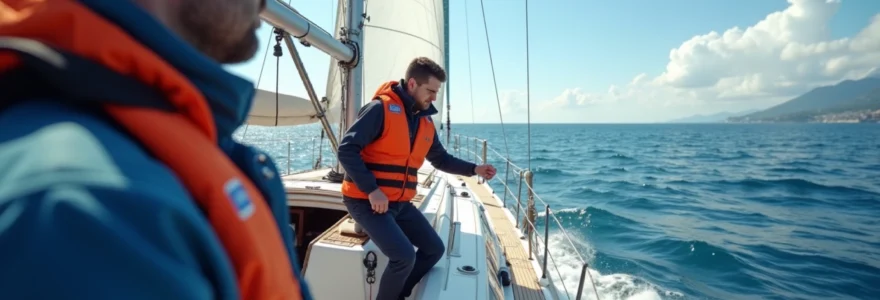Embarking on a sailing holiday offers a unique blend of adventure, relaxation, and personal growth. The allure of open waters, picturesque coastlines, and the freedom to explore at your own pace makes sailing an increasingly popular vacation choice. However, to truly make the most of this experience, understanding the fundamentals of sailing is crucial. Not only does it enhance safety and confidence on board, but it also deepens your connection with the sea and the art of navigation.
Mastering key sailing skills transforms a simple holiday into an immersive journey, where each day brings new challenges and rewards. From the satisfaction of tying a perfect knot to the thrill of navigating through challenging weather, these skills elevate your maritime adventure. Let’s explore how learning the essentials of sailing can turn your holiday from memorable to truly unforgettable.
Fundamentals of nautical navigation for sailing holidays
Nautical navigation forms the backbone of any successful sailing trip. It’s not just about getting from point A to point B; it’s about understanding your position relative to the ever-changing seascape around you. Modern sailors have the luxury of GPS and electronic charts, but understanding traditional navigation methods provides a deeper appreciation of the art and a crucial backup in case of technology failure.
Learning to read nautical charts is akin to decoding a treasure map of the seas. These charts provide critical information about water depths, potential hazards, and navigational aids. Mastering the use of a compass and understanding how to plot a course considering factors like wind, currents, and tides are essential skills that enhance your sailing experience.
One of the most rewarding aspects of learning navigation is the ability to plan your own routes. This skill allows you to discover hidden coves, secluded beaches, and charming coastal villages that might be overlooked by less adventurous sailors. It’s about crafting your own unique journey, tailored to your interests and the desires of your crew.
Understanding dead reckoning – the process of calculating your current position based on a previously determined position – adds an element of traditional seamanship to your skillset. This method, while seemingly outdated, provides a fundamental understanding of your vessel’s movement through water and can be a lifesaver if modern equipment fails.
Essential sailing knots and ropework techniques
Mastering a repertoire of sailing knots is not just a practical skill; it’s an art form that connects you to centuries of maritime tradition. Each knot serves a specific purpose, from securing your vessel to a mooring to hoisting and trimming sails efficiently. Learning these knots and understanding when to use them can significantly enhance your sailing experience and safety on board.
Mastering the bowline: the king of sailing knots
The bowline, often referred to as the ‘king of knots’, is perhaps the most versatile and essential knot in a sailor’s arsenal. Its ability to create a secure loop that won’t slip or jam makes it invaluable for a multitude of tasks on board. Whether you’re attaching a halyard to a sail or creating a temporary mooring point, the bowline is your go-to knot.
Learning to tie a bowline quickly and efficiently, even with one hand, is a skill that will serve you well throughout your sailing adventures. Practice until you can tie it with your eyes closed – you never know when you might need to secure a line in challenging conditions or low light.
Cleat hitch for secure mooring in mediterranean marinas
When mooring in bustling Mediterranean marinas, a properly executed cleat hitch is essential. This knot secures your vessel to a dock or mooring buoy, ensuring it stays put regardless of changing tides or weather conditions. The beauty of the cleat hitch lies in its simplicity and strength – when tied correctly, it can hold tremendous weight yet be easily released when needed.
Mastering the cleat hitch involves understanding the proper technique of wrapping the line around the cleat in a figure-eight pattern, finishing with a locking turn. This knowledge not only secures your boat but also demonstrates your competence as a sailor to fellow mariners.
Figure-8 knot: preventing line slippage on winches
The figure-8 knot serves as an excellent stopper knot, preventing lines from slipping through fairleads, blocks, or off winches. Its bulky nature makes it ideal for creating a temporary endpoint on a line, ensuring safety and control during various sailing maneuvers.
Learning to tie a figure-8 quickly becomes second nature with practice and is an essential skill for efficient sail handling. It’s particularly useful when preparing lines for use with winches, where preventing accidental release is crucial for both performance and safety.
Sheet bend for joining lines of different diameters
The sheet bend excels at joining two lines of different diameters or materials. This versatility makes it invaluable on a sailing holiday, where you might need to extend a line or create a makeshift towing arrangement. The sheet bend’s ability to hold securely, even under load, while remaining easy to untie after use, makes it a favorite among experienced sailors.
Mastering the sheet bend adds flexibility to your ropework skills, allowing you to adapt to various situations that may arise during your sailing adventure. It’s a perfect example of how a simple knot can solve complex problems at sea.
Weather pattern recognition for safe coastal cruising
Understanding weather patterns is crucial for safe and enjoyable coastal cruising. While modern technology provides accurate forecasts, developing the ability to read the sky and sea conditions enhances your sailing experience and safety. This skill allows you to make informed decisions about your route and sailing plans, adapting to changing conditions with confidence.
Learning to identify cloud formations and their implications for upcoming weather is a fundamental skill. Cirrus clouds , for instance, often herald a change in weather, potentially signaling the approach of a front. Recognizing the signs of an impending squall or understanding how local topography affects wind patterns can make the difference between a challenging sail and a comfortable journey.
Observing sea state and its relationship to wind conditions is another crucial aspect of weather recognition. The development of whitecaps, for example, provides visual cues about wind speed, helping you gauge when it might be time to reef the sails or seek shelter.
Understanding the basics of pressure systems and their influence on local weather patterns empowers you to make more accurate short-term predictions. This knowledge is particularly valuable in areas known for rapidly changing conditions, such as the Mediterranean, where afternoon sea breezes can significantly impact sailing plans.
Developing weather pattern recognition skills transforms you from a passive recipient of weather information to an active interpreter of your environment, enhancing both the safety and enjoyment of your sailing holiday.
Sail trim optimization for various wind conditions
Mastering sail trim is where the art and science of sailing truly come together. Proper sail trim not only improves your vessel’s performance but also enhances comfort and reduces strain on the boat and crew. Understanding how to adjust your sails for various wind conditions is key to making the most of your sailing holiday.
Mainsail trimming techniques for upwind efficiency
When sailing upwind, efficient mainsail trim is crucial for maximizing your boat’s performance. The goal is to find the perfect balance between power and pointing ability. Learning to use telltales – small strips of fabric attached to the sail – helps you visualize airflow and adjust the sail accordingly.
Understanding how to use the mainsheet, traveler, and vang in concert allows you to control the sail’s shape and angle of attack. In lighter winds, a fuller sail shape generates more power, while in stronger winds, flattening the sail reduces heeling and improves pointing ability. Mastering these adjustments transforms upwind sailing from a chore into an exhilarating experience.
Headsail adjustment for reaching in aegean breezes
The Aegean Sea, known for its consistent summer breezes, offers perfect conditions for reaching – sailing with the wind coming from the side. Proper headsail adjustment is key to harnessing these winds effectively. Learning to adjust the headsail’s shape using the halyard tension and sheet angle allows you to maximize drive while minimizing heeling force.
Understanding how to use the fairlead position to control the sail’s twist is crucial for efficient reaching. Moving the fairlead forward flattens the bottom of the sail, ideal for stronger winds, while moving it aft adds power in lighter conditions. This knowledge allows you to fine-tune your sail plan to the specific conditions of the Aegean, enhancing both speed and comfort.
Spinnaker handling for downwind runs in the balearics
Sailing downwind in the Balearic Islands often provides the perfect opportunity to fly a spinnaker – a large, colorful sail designed for maximum efficiency when the wind is behind you. Mastering spinnaker handling adds an exciting dimension to your sailing skills and can significantly increase your boat’s speed on downwind legs.
Learning the process of setting, trimming, and dousing a spinnaker safely is crucial. Understanding how to adjust the pole height and position, as well as managing the sheet and guy lines, allows you to harness the full power of the wind. While challenging at first, the thrill of sailing under a well-trimmed spinnaker in the crystal-clear waters of the Balearics is unmatched.
Reefing procedures for gusty mediterranean conditions
The Mediterranean is known for its sometimes unpredictable and gusty conditions, making knowledge of reefing procedures essential. Reefing – the process of reducing sail area – allows you to maintain control and comfort in stronger winds. Learning when and how to reef efficiently is a crucial skill that enhances safety and enjoyment during your sailing holiday.
Understanding different reefing systems, whether slab reefing or in-mast furling, and practicing the procedure in calm conditions prepares you for when the wind picks up. Quick and efficient reefing can turn a potentially overwhelming situation into a manageable and even enjoyable sailing experience.
Anchoring strategies in popular european sailing destinations
Mastering the art of anchoring is crucial for any sailing holiday, especially in popular European destinations where finding the perfect spot to spend the night can be challenging. Understanding different anchoring techniques and how to choose the right location based on seabed composition, depth, and weather conditions is essential for a safe and comfortable stay.
Learning to read charts and identify suitable anchoring spots is the first step. This involves understanding depth contours, recognizing potential hazards, and considering factors like wind direction and potential shifts. In popular Mediterranean anchorages, where space can be limited, knowing how to calculate the appropriate scope (the ratio of anchor rode to water depth) is crucial for both safety and courtesy to other boats.
Different anchoring techniques suit various situations. The Bahamian moor , for instance, uses two anchors set at different angles to limit swinging in tight anchorages or reversing tides. Mastering this technique can open up anchoring possibilities in crowded or challenging locations.
Understanding how to set and check your anchor properly is vital. This includes knowing how to approach your chosen spot, deploying the anchor at the right moment, and backing down to ensure it’s set securely. Learning to recognize the signs of a dragging anchor and how to respond quickly can prevent potentially dangerous situations, especially in changing weather conditions.
Developing proficiency in anchoring not only ensures your safety but also allows you to discover secluded bays and coves off the beaten path, enhancing the exploration aspect of your sailing holiday.
Basic marine VHF radio protocol for international waters
Effective communication is paramount for safety and efficiency when sailing, especially in international waters. Understanding and adhering to proper marine VHF radio protocol is not just a matter of etiquette; it’s a crucial safety skill that can make a significant difference in emergency situations.
Learning the correct use of VHF channels is fundamental. Channel 16, the international distress and calling channel, should always be monitored while at sea. Knowing when and how to use other channels for various purposes – such as ship-to-ship communication or contacting marinas – is equally important for smooth operations during your sailing holiday.
Mastering proper radio etiquette includes understanding how to structure a call, using correct terminology, and speaking clearly and concisely. This skill becomes particularly valuable when communicating with vessels or shore stations from different countries, where clear and standardized communication helps overcome language barriers.
Familiarizing yourself with distress procedures is crucial. Knowing how to issue a Mayday call in case of immediate danger, or a Pan-Pan call for urgent situations that are not immediately life-threatening, can be lifesaving. Understanding how to respond to distress calls from other vessels is equally important, as it’s a fundamental aspect of maritime law and ethics.
Learning to use the phonetic alphabet (Alpha, Bravo, Charlie, etc.) for spelling out names and locations ensures clear communication, especially in poor reception conditions or when dealing with accents and language differences.
Understanding and respecting radio silence periods, typically observed for three minutes after each half and full hour on Channel 16, allows for uninterrupted monitoring of potential distress calls.
By mastering these basic VHF radio protocols, you not only enhance your safety at sea but also become a more confident and responsible sailor, capable of communicating effectively in various situations encountered during your sailing adventures.


